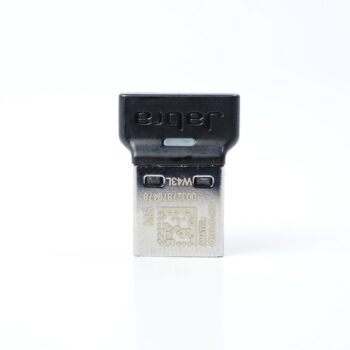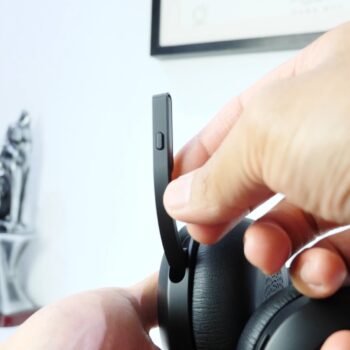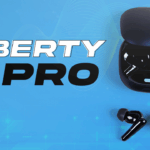Welcome to the review of the Jabra Evolve2 75 headset. This is Jabra’s latest headset and supports active noise cancelling (ANC) which is great for using in noisy environments.
This is a noise cancelling headset so it’s perfect to use in noisy environments like at home if you have kids being loud in the background, working in a call center or if you work in an open office concept environment.
It’s available for $499 (CAD) or $399 (USD).
Connectivity
Right off the bat, this is where things are bad.
The headset uses wireless connectivity via Bluetooth to connect to your phone or computer. There’s also a USB Bluetooth receiver. The USB is available in USB-C fitting or USB-A.
Unfortunately, both Bluetooth and the USB receiver connection options perform poorly. If you’re using the receiver to take calls on a computer, it works great for calls but is terrible for other audio sources like Spotify, YouTube, etc. For some reason, using the receiver makes the computer think it’s always on a call which then causes other audio sources (like listening to music) to sound muffled.
The obvious workaround is to stop using the USB receiver and start using regular Bluetooth, but it has its own major issue. All audio sources sound great and taking calls also sound fantastic, but after hanging up the call and jumping to the next call, I can’t hear anything. People on the other end can hear me but I can’t hear them. The only fix is to leave the call, turn the headset off, turn it back on and rejoin the call.
There are a fair number of posts (mainly on Reddit) of people complaining about the same issues. In fact, on some online retailer websites, this headset gets mixed reviews due to the same issue. Not being able to connect for basic audio capabilities makes this headset worth considering to be skipped, especially with its heavy price tag.
I tried this headset on 3 computers. The first computer with all the issues mentioned earlier, the second computer played music with great clarity with the USB receiver but would randomly lose connection to the receiver and the last computer worked fine. It basically means you’re taking a gamble with connectivity. And yes, I did basic troubleshooting on all computers like fully update Windows, update all drivers, update the USB receiver and headset firmware and so on.
The Jabra Evolve 75 that I reviewed two years ago (found here) doesn’t have any of these issues. Even as my primary headset it still runs like a champ, no connection issues and battery is still a solid performer.
Continuing with the rest of the review, the USB receiver is thankfully small so there is little concern of it getting damaged while it might be connected to a laptop in a laptop bag.
This headset does support dual connectivity. To accomplish this, you must have the USB receiver connected to a computer and Bluetooth on another device like a smartphone. However, it only allows audio to communicate with one device at a time which is normal behaviour.
Adding to the other connection issues, while I was connected to the USB receiver and my phone at the same time, audio from my phone couldn’t be heard. I had to disconnect the receiver on my computer before I could hear phone audio. In addition, at random times Bluetooth will disconnect from my cellphone.
Headset connectivity advertises a 30-meter (close to 100 feet) range, in my testing I was able to reach 50 feet due to space limitation. However, in that 50 feet sound quality remained rather clear. Thankfully in most use cases, you’ll never need to go even 50 feet.
Accessories
A traveller’s pouch is included in the box but it’s soft, which is rather disappointing for such an expensive headset. A hard case would have been better to protect such an expensive headset.
Apart from the USB receiver that comes with the headset, there’s a USB-C to USB-A cable for charging which is 4 feet in length. There’s no power adapter included as you’re expected to charge it through your computer or other means.
There’s also a sold separately charging dock which connects to the pins on one of the earcups.
Body design
This is seriously a sleek looking headset. From most angles they look like regular headphones with the mic arm up.
The body felt a little weak in my hands at first but thankfully those concerns were eliminated quickly as I come to realize that the body is well built.
Wearing this headset is quite comfortable. Only after wearing them for four hours straight did they start to irritate me a little, but I just need to simply adjust them a bit and I’m fine. My ears never got too warm or sweaty during lengthy tests.
I think the reason they irritate me a bit after a few hours of use is due to the tight flex of the headband, it presses inwards on the head compared to the Evolve 75 for example (its body flex is a bit looser). The Evolve 75 provides almost no irritation even after wearing them six hours straight.
At rest (while sitting on my shoulders around my neck and not my ears) the headset sits rather narrow due to the slightly tight inward flex of the headband. Thankfully while it’s on my neck, I can easily turn my head left, right and looking down is relatively easy.
For those with little or no hair, you’re in luck as the top band has a soft cushioning which provides additional comfort.
The leatherette on the earcups is one of the key items to making this headset comfortable to wear. The cushioning has decent thickness as well.
The ear cups also have decent rotation to accommodate various head structures and ear types. They’re able to rotate forward and back as well as up and down.
The headset has decent extension reach so if you have a longer head, the earcups should rest on your ears nicely.
When a call is incoming, the headset LEDs will flash. While on a call, the headset is supposed to emit a red light, letting people know to not disturb you except it doesn’t work half the time weather it’s being used on a computer app or cellphone call.
MS and UC Version
There are two versions to purchase of this headset which makes it really confusing but I’ll help break it down. There’s the MS version or the UC version.
The MS version means it’s designed to seamlessly work with Microsoft tools such as Teams. For example, the headset will display dedicated colour status to match your Teams call status. Another feature is if you press the Teams button on the headset, it’ll open the Teams app to the front of your view.
The UC version which stands for Unified Communication is for everything else such as Cisco Jabber, Zoom, Go-To Meeting, Webex, and even Microsoft Teams.
Long story short, there’s no real reason for the MS Teams version. It’s nothing special, you can do just fine with the UC version. In fact, the UC version works just fine with Microsoft Teams. Having two versions just makes more confusing for consumers.
Noise Cancelling
Simply putting on this headset while powered off already reduces background noise because this is an on-the-ear headset. Turning the headset on turns on ANC. It does a pretty good job of cancelling background noise. Probably one of the best on the market for a headset with a boom microphone.
ANC performance is the same whether you’re connected with Bluetooth or the USB receiver, ANC performance doesn’t get degraded with either connection type.
Controls
On the left earcup ANC can be turned off from the ANC button by holding down on the button. Simply tapping the button will activate hear through, which uses the microphones on the headset to allow sounds outside the headset to be easily heard, as if you weren’t wearing the headset at all.
Just below is the power switch to turn it off and on. Sliding and holding the switch to the Bluetooth symbol will turn on Bluetooth pairing mode.
On the right earcup there are two buttons on the back for volume up and down (also used for next track and previous track if you hold the buttons down). There’s a weird issue with volume on Windows computers. Tapping volume up or down will cause volume to jump between 2% to 20% in adjustment and it’s completely random. If volume is too low and I tap volume up, at random times it can get too loud.
The middle button between the volume buttons will play pause music. I often press the middle button thinking I’m lowering volume; the placement of the play/pause button is rather poor.
Pressing the side button will answer or hang up a call which works perfectly on Teams, Cisco Jabber, Zoom and Go-to Meeting in my testing (regardless of the MS or UC version).
Moving the boom mic up while on a call will mute the mic or simply pressing the mute button on the boom mic itself will also work. The same mute button can activate voice assistant on your smartphone if it’s supported.
It is possible to talk while the boom mic is up, you just need adjust this feature in the Jabra software which I’ll go over later.
Battery
I’m happy to see that the charging port is a USB-C fitting.
The battery is consumed the fastest while using the microphone and ANC is active. I average about 14 hours talk time use on a single charge with ANC on and that also means having the headset on without being used for another 4 hours. Jabra advertises 18 hours non-stop talk time with ANC on so their claim seems pretty accurate.
It takes me about 2 hours and 30 minutes to charge the headset.
Audio Quality
Audio quality is a mixed bag due to the connectivity issue. Ignoring that, the microphone does a pretty good job of cancelling surrounding noises, so it focuses on the sound from your voice and tries to cancel background noise around the user. The audio quality of the microphone output is rather clear and sounds good. This makes it great for use in noisy environments.
For listening to music, it’s it works surprisingly well for a headset. Mids and highs sound surprisingly well, bass is a little low but adjusting it with the Jabra software fixes that.
When it comes to playing action videos games or movies with explosions it sounds awesome. If the sound of the source is good, it’ll sound as if the action is coming from all directions.
Software
You can download firmware updates from Jabra’s website and there’s software called Jabra Direct that allows you to customize features like if the boom mic is up, it’ll mute the mic or not, turn off voice audio cues (like when the headset tells you battery time remaining when turning on the headset), equalizer settings and other features.
There’s a Jabra app for cellphones called Jabra Sound+ which allows you to control certain functions of the headset while mobile. It has an option to allow you to press the mute button to activate your Voice Assistant but it’s never worked on my Android phone.
Score:
5/10
Pros:
-Small USB receiver
-USB-A and USB-C receiver options
-Range
-Attractive design
-Sturdy body
-Comfortable
-ANC performance
-Powered off still reduces background noise
-Comfortable while resting on neck
-Music controls
-Battery performance
-Multiple ways to mute mic
-Mic clarity
-Mic background noise cancellation
-Decent computer & mobile apps
-Good for movies, music and video games
-Optional charging dock
-Use mic with boom arm up
Cons:
-MAJOR connection issues
-Price
-Soft traveller’s pouch
-MS and UC version confusing and almost pointless
-Play/pause button placement
-Busy status light doesn’t work properly
-Random volume jump on computers
-Voice assistant button for phones doesn’t work properly












